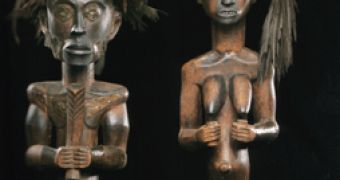One of the main Bantu tribes in central Africa is represented by the Fangs, who inhabit Equatorial Guinea, Cameroon and Gabon. The Fangs came from Nigeria recently, during the Bantu expansion. Fang legends speak about terrible battles their ancestors fought against warriors covered by long clothes and riding horses. The legends say that the Fang people were expelled from their former territories by red giants; fleeing from them, they reached a river they could not cross, but an enormous snake formed an Arch with its body and family after family could move to the other bank. But a woman killed the snake and the other Fangs could not cross the river.
The legends bear a beat of truth: the Fangs were forced out of Nigeria by the Islamized tribes of Hausa, which wear long clothes and are skilled riders; on their way, the Fangs had to cross the Sanaga River, which poses serious difficulties, and one Fang fraction, the Beti, still live on the other bank of the river. The Fangs came from a savanna area and had to adapt to the rain forest.
The Fang population live on a plateau having an average altitude of 600 m (2,000 ft), separated from the coast by a chain of low mountains. The clime has two seasons: wet and dry. The forest is made of giant trees, including ebony, mahogany, okoume, bamboo and others.
Fang villages are located in forest clearings. They consist in a small number of huts made of trunks, branches and straw; the roof is conic or in two slopes and the greatest part of the daily activity (cooking, cereal grinding, banana paste making in large mortars) is performed outside, as the interior of the huts is dark, small, badly aerated and it is only used for sleeping sheltered against rains.
Each village has one larger hut, built away of the others, called the "House of the Word". There men gather for chatting, smoking, changing impressions and solving issues of the village; women are forbidden even to approach this house. This house harbors the bones of the most important ancestors of the clans that formed the settlement. Usually, each village is made of 2 or more clans (social unities made of individuals considered to descend from a common ancestor, who can be a great chief, a hero, a deified character or even an animal).
The Fangs believe in the existence of a mighty and eternal god, called Mebe'e, who created the world and all living creatures, but, disgusted with the evilness of his creation, he pretended not to know about the world and left Ndzame, the common father and ancestor of all the clans, to rule the world. Each person considers his/her life is determined by the influence of the spirits of the ancestors. To achieve their mediation for solving the daily life hardships, the Fangs practice the cult of the ancestors. The focus of the cult was in other times the bieri, a box made of tree bark in which they preserved the bones of an important person, and over which they placed a figurine representing his spirit. This figurine and the masks used during the ritual dances represented Fang art works.
Like most of the Bantu people, the Fangs belong to the Congo racial type of the Black African race, with some Sudanese contributions. The Fangs are rather tall, well built, with dark brown skin. The face has a marked prognathism, the lips are very thick and turned outside; the nose is very wide and flattened; the hair is curly and woolly.
The Fang men are mainly hunters, while the women are those charged with farming; men only do agricultural tasks requiring power, like burning new forest patches and plowing and clearing them for new plots. This task can be realized quite often, as the fields are not fertilized.
The Fang people practice polygamy, and each wife lives in an independent hut with her sons under the strict rule of the husband, his male relatives, the members of his clan and her mother in law. The women farms the fields of the husband (by having more wives, the men has more work power), and beside this, they gather wild fruits and fish in the rivers. Women also take care of and educate the children, fix the huts, make ceramics, raffia fabrics and fishing nets.
The women work the land using hoes. They sow, weed out and harvest. Once the woman has covered the needs of the family, she can use the fruits of her work with some degree of freedom. The main Fang crops are manioc, corn, banana and oil palm. Europeans also introduced plantations of coffee and cacao.
Men fish using traps and large nets. Women too can fish using rods and hooks. In streams, men use bag nets, manipulated by long sticks, for fishing. The Fang people also use traps for hunting all kind of animals, from birds to elephants. Before the introduction of the fire arms, the Fangs hunted using crossbows, machetes, spears, arrows with iron tips, from forest buffalo to antelopes, chimps, gorillas and elephants. One of the most appreciated dishes by the Fangs are the Goliath frogs (Conraua goliath), world's largest living frogs (30 cm or one foot in body length, weighing 3 kg or 7 pounds). Coastal Fangs also fish in the sea from their fragile canoes, and sea turtles are considered an exquisite dish.

 14 DAY TRIAL //
14 DAY TRIAL //